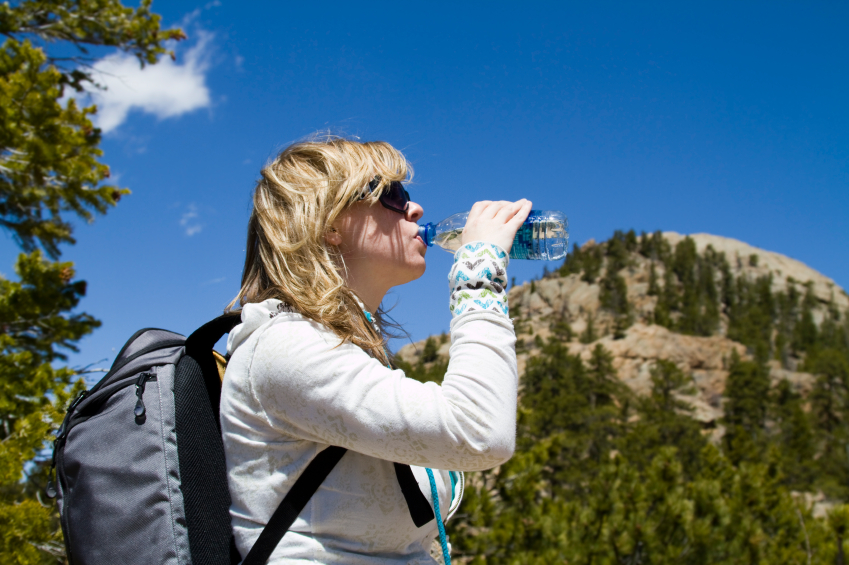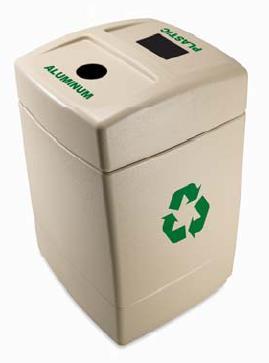 Hiker with bottled wate
Hiker with bottled wate
Just like the way a pebble thrown into a pond creates a rippling effect, so does talk of the National Park Service's proposed ban on the sale of bottled water.
This decision is creating quite a splash with environmentalists, the bottled water industry, Coca-Cola, Congress and other interested parties.
The issue is a serious one. As you can imagine, with the millions of people who visit our national parks every year, they can generate quite a few empty water bottles.
In its effort to be more green and sustainable, the National Park Service proposed ending the sale of all bottled water at its facilities - in their stores and vending machines. (Note, visitors can still bring in their own bottled water purchased elsewhere).
Many parks have already initiated this ban - some well-known names include The Grand Canyon, Mount Rushmore, Little Bighorn, Zion National Park and Dinosaur National Monument.
Zion National Park officials reported they felt the ban was successful as their program in 2008 eliminated 60,000 plastic bottles from the park in its first year. The NPS gave them an environmental achievement award for their effort.
Used water bottles reportedly accounted for 30% of the total waste in the park and strewn bottles were the number one source of trash in the canyon.
To offset the lack of bottled water for sale, the park service has encouraged individual parks to offer "filling stations" where people could bring their own water containers and fill them up.
"Reducing and eliminating disposable plastic bottles is one element of our green plan. This is a process and we are at the beginning of it," said NPS spokesperson David Barna.
Sounds worthwhile, right?
Well, just like any issue, there's another side to this story.
For one, people from the bottling industry say the ban has an adverse effect on people's health because if people can't buy water from park facilities, they are going to buy soft drinks. Sugary soft drinks. The kind that First Lady Michelle Obama wants people to stop drinking or at least reduce their consumption in her cause against obesity in the US.
Secondly, as any hiker knows, it can get hot out there. Some people are just not going to be able to bring their own water containers, especially large families where it might be hard enough just to get everybody into the car on time.
"Banning bottle water defies common sense," said Congressman Keith Rothfus of Pennsylvania. "Families who don't own expensive camping equipment and aren't experienced hikers and climbers will be surprised to find out that they can't buy their child a bottle of water at one of our national parks."
He added, "Temperatures at the Grand Canyon just this week will top 100 degrees. Visitors who may have forgotten or have run out of water could be put at risk of dehydration."
Coca-Cola, which sells a boatload of bottled water under the brand, Dasani, has also voiced their opposition to the ban. Adding to the dilemma, Coca-Cola is a big supporter of the parks, donating about $13 million per year.
Because of the controversy, the NPS Director Jon Jarvis has decided to put a hold on the ban until more research can be conducted and more alternatives are explored.
We get it. No one wants to see trash at our national parks.
But on the other hand, people need to hydrate. Most don't drink enough water as it is. And certainly turning to soda while hiking is not a great alternative.
Add more recycling receptacles to promote sustainability
Maybe there's a compromise that can be worked out. Here are a few suggestions:
Recycling receptacles - the park service reports that the volume of disposed water bottles is just taking up a lot of space in their waste containers. In fact, they show a picture of a trash container overflowing with bottles. This actually creates an opportunity. Why not distribute more recycled trash bins so people can separate their plastic bottles from others trash? (In the spirit of disclosure, the Park Catalog sells recycling bins).
 Recycling receptacl
Recycling receptacl
This encourages recycling and sustainability. Ironically, the demand now for recycled plastic scrap exceeds the supply. Manufacturers have refined the process of making goods out of recycled plastic to the point where these are now top-grade products. For example, recycled plastic benches and recycled plastic picnic tables (note: The Park Catalog sells these park furnishings as well).
In the early years, these products were substandard and some manufacturers would use cheap sawdust as filler.
But now, the process to make these benches and picnic tables has been refined. These products are now more durable, require less maintenance and last much longer than equivalent wood products.
There is an education opportunity here that could have a major impact on the whole concept of sustainability nationwide. Not only place recycling receptacles around parks, but display recycled plastic benches and recycling plastic picnic tables - show the end result of that recycling.
Because recycling scrap is just the first part of the three part recycling process - Collection, Manufacturing and Purchase.
This is how the recycling path actually works. Products are manufactured out of plastic which is oil-based and must be pulled out of the ground. Once used, those products, such as milk jugs and drinking bottles, are then gathered and sent to recycling centers. From there, the plastic scrap is sorted, melted and remade into other products.
People then purchase these products, thereby reducing the original need to use raw materials and using quite a bit less energy required manufacture plastic products.
Again, ironically, the demand for plastic scrap is huge. According to EPA, only about 7% of reusable plastic is actually recycled. What an enormous opportunity to gather all those plastic products and cut back on the use of raw materials.
Obviously, this is a complex issue. Not every hiker is going to use a recycling container or any container for that matter.
Perhaps the answer is to provide more education. What a great opportunity to let people know, hey, we know you need bottled water for your hike today. But did you know there is a huge demand for that empty plastic bottle in your hand? Please drop it in the recycling bin. You will not only be helping the park, but you will be helping the planet in general because the plastic from that bottle can now be reused. As it is in that recycled plastic bench you are now sitting on.
Definitely fits in with the whole concept of sustainability, which is to use and reuse fewer resources now so there are more resources available for later generations.
A solution is not going to be found overnight. Jarvis' decision to hold off on the total ban of water sales sounds like a good one. There are many opportunities here to help the environment. Adding more recycling receptacles might be one solution. They just need to be sorted out.
To read about this discussion to ban the sale of bottled water, click here.


